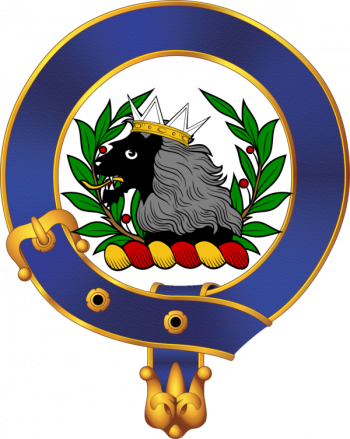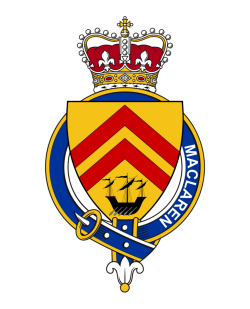
Clan MacLaren
CREAG AN TUIRC
There are two possible lines of descent for clan MacLaren. One branch, from the isle of Tiree in Argyll, comes from Fergus MacErc, the founder of the ancient kingdom of Dál Riata. The other branch is said to originate from Laurence, Abbot of Achtow, who lived in Stirlingshire.
The MacLaren clan motto is "Creag an Tuirc" (The boar's rock) and the clan crest is a lions head with a crown, surrounded by laurel branches.
The Tartans
of Clan MacLaren
Scottish History
of Clan MacLaren
Lords of Balquhidder
The Clan Maclaurin, nowadays more commonly spelled MacLaren, was the name of a small tribal grouping belonging to west Perthshire and called in Gaelic the Clan Labhrin, this name being derived from the Gaelic name for the district of Lorn in Argyll.
As a result, the MacLarens bear the word ‘Dalriada’ - the old name for Argyll - above their coat of arms.
Romantic legend relates how the clan was descended from the seduction of warriors by mermaids, one of whom appears in their armorial bearings drawn up by the Lyon Court in the eighteenth century.
A more plausible yarn tells how one of the three sons of the Ulster King Fergus MacErc crossed over from Ireland and founded a fiefdom in Argyll in 503 which eventually stretched from Tiree into the central Highlands. It is from these Irish colonists that the Maclaurins originally claimed descent.
The actual name Laurin may be a local dialect variation of Lawrence, a Christian martyr who suffered under the pagan Emperor Valerian’s persecutions in 261 A.D.
A local Father Lawrence became Abbot of Achtow in Balquhidder in the thirteenth century and he was closely associated with the clan, being viewed as their unofficial ‘padre’.
From the west coast the tribe of Laurin moved inland to Perthshire, having acquired from King Kenneth Macalpine, after his conquest of the Picts in the ninth century, the districts of Balquhidder and Strathearn.
Three brothers are recorded as having assigned to them in that territory the lands of Bruach, Auchleskin and Stank; and even in death, in the quaintly atmospheric Balquhidder kirkyard, which is celebrated for containing the graves of Rob Roy and his family, the burial places of the Laurin men are marked off in a special order so as to correspond with the topography of their estates and their corresponding rank in the clan.
The Maclaurins became followers of the mighty Celtic Earls of Strathearn and fought ferociously as allies in several major battles, including Bannockburn and, less successfully, at Sauchieburn in 1488 when King James III was defeated by rivals to his throne.
Maclaurins were also among those mown down by the billhooks of pikes and showers of arrows in the bloody mire of Flodden where their bodies were found near the slain king they had fought stalwartly to defend to the end.
They also fought for that tactical genius, the Marquis of Montrose, in his Royalist victories at Inverlochy, Auldearn, Alford and Kilsyth.
They also were in the forefront of the famous Highland charge that won the battle of Killiecrankie under the inspiring leadership of Claverhouse; and were consequently ‘out’ in all the succeeding Jacobite uprisings, eventually paying dearly – like so many other proud Highlanders – for their courageous loyalty to the lost Stuart cause.
In 1497, some of the clan of Laurin having carried off cattle from the Braes of Lochaber, the Macdonalds, the rightful owners of the cows, chased after the rustlers to get their herd back; and, overtaking them in Glenurchy, after a short, brutal fight recovered their four-footed goods.
The Maclaurins immediately sought the assistance of their kinsman, Dugal Stewart of Appin.
His mother was a Laurin and he was the illegitimate son of John Stewart, third Lord of Lorn. Some years previously the Maclaurins had been on his side when he tried vainly and illegally to seize his father’s lands and 130 clansmen had fallen in a bloody battle that had taken place at the foot of Bendoran, a mountain peak in Glenurchy.
Dugal therefore was only too keen to help out the Maclaurins with his followers; and the Macdonalds were in turn hunted down. A savage fight took place at the Black Mount, near the head of Glencoe, during which Dugal was killed as was Macdonald of Keppoch, leader of his clan.
The battle proved indecisive and the cattle that had been the root of the problem merely stampeded wildly into the heather clad hills as the slopes turned red with the blood of dead clansmen.
Balquhidder, by the picturesque shores of Loch Voil, became renowned as ‘the country of the Maclaurins’ which they were determined to hold by force of arms against all incomers.
So powerful were they in the area that nobody dared to enter the kirk until all the Maclaurins had taken their seats.
But even this seemingly peaceful tradition sometimes led to violence as there were unseemly brawls at the church door; and in 1532, the local minister himself, the Rev. John Maclaurin, was killed at the door and his murderers outlawed as a result.
Behind the kirk stood the rallying place of the clan known as Creag an Turic (‘The Boar’s Rock’) which is a small hill overlooking the surrounding territory and approached by a steep path.
Thus ‘Creag an Turic’ became the clan’s battle cry; and in 1987 the MacLaren Clan Society erected a cairn on top of this rallying point.
Lethal feuds
A deadly feud existed between the Maclaurins and the MacGregors since the latter were being persecuted by the Campbells around their traditional fiefdoms on the shores of Loch Lomond and were being unwillingly pushed into Perthshire.
The untamed MacGregors were notorious for pillaging and plundering; and in the sixteenth century they slaughtered 18 householders of their Maclaurin rivals and took possession of their farms. Even women and children were slaughtered.
It took another 46 years before these crimes were even investigated and the culprits brought to book: but a court intimidated by their kinsmen found the accused not guilty.
It needed Stewart of Appin two centuries later to regain the farms for the Maclaurins - and he could only do it at the head of 200 bloodthirsty and heavily armed warriors.
It did them little good in the long term because the properties were seized by the Crown after the ’45 when the Maclaurins were condemned as rebels; and ironically in 1798 the farms were legally bought at a knockdown price by the chief of the MacGregors from the Commissioners of the Forfeited Estates.
In the ’45 the Maclaurins followed the flags of the Murrays of Athole and the Stewarts of Appin. They fought throughout the campaign and savoured the sweet success of early victory and the bitter taste of final defeat.
Such was their notoriety that the Maclaurins were listed in government warrants as being ‘among the most dangerous of West Highland clans’.
At Culloden they had fought bravely alongside the Appin regiment under Lord George Murray, brother of the Duke of Atholl, who in Gaelic urged them into one last futile but breathtakingly audacious charge which actually broke the Hanoverian line of redcoats before running out of momentum.
Donald MacLaren of Wester Invernentie was taken prisoner after Culloden, having watched a dozen of his kinsmen killed by musket fire.
He was being marched south to face trial and almost certain execution at Carlisle when the armed party made its way through the rocky defiles of the Lowther Hills above Moffat.
The prisoner, who had formerly driven his cattle southward to English markets by the same route and knew the terrain well, asked to relieve himself at the abyss which formed the vast natural grassy hollow known as the Devil’s Beeftub where cattle rustlers were fond of hiding their ill-gotten gains.
Free for a fleeting moment from his escorts, he seized the opportunity by leaping over the edge of a cliff and plunging into a peaty bog many feet below where he promptly placed a turf on his head.
Eluding his pursuers until nightfall, he then returned back home to Balquhidder where he lived, disguised as a woman (he even had a few passing flirtations), until the Act of Indemnity set him free to reveal his true self.
This episode was later used by Sir Walter Scott in his novel Redgauntlet.
Another rival clan were the neighbouring Buchanans; and, in the mid-sixteenth century, a country fair took place at Kilmahog at the foot of the Pass of Leny where one of the young gallants from the Maclaurins of Balquidder was strolling along when he ran into a Buchanan who, in jest, lightly struck him across the face with the tail of a newly caught salmon he was carrying.
The young Maclaurin man went red in the face and then challenged his assailant to do the same thing with a fish’s tail the following month at the Balquhidder fair.
The Buchanan youth apparently went home and totally forgot about the incident: but on the day of the Balquhidder gathering, as the Maclaurins were relaxing and enjoying themselves buying, selling and taking part in vigorous sports, word suddenly arrived that a considerable body of Buchanans was marching up through Strathyre and were already no further away than the nearby Clachan of Ruskachan.
It was during these tense moments that the affronted Maclaurin youth who had received the fishy slap in the face took it upon himself to loudly recall the insult.
The fiery cross was swiftly sent round the clan country and the Maclaurins rushed to arms, eager for a fight.
By the time the Buchanans had arrived on the scene, the Balquhidder men were well outnumbered since their clansmen had not yet arrived in from the surrounding countryside.
But, nothing daunted, they charged wildly into the fray, though at first the interlopers carried all before them.
The Maclaurins were driven back for a mile where reninforcements arrived and the Buchanans were surrounded and systematically massacred, only two of them escaping by swimming a cold, frothy river, though even this pair were hunted down and slain with a bloodthirsty efficiency typical of those warlike times.
Family History Mini Book
We hope you enjoyed reading this excerpt from this mini book on the Scottish history of the MacLaren family.
You can buy the full book for only114 Clan MacLaren
Tartan Products
The Crests
of Clan MacLaren










































































